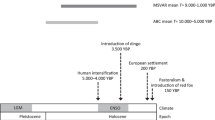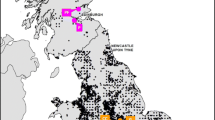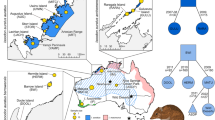Abstract
Since European settlement, mainland Australia has experienced a wave of mammal extinctions and population declines. However, some species have persisted on off-shore islands, which are now viewed as important wildlife refuges. In this study, we assessed the level of genetic diversity, at 7–11 microsatellite loci, in island and remnant mainland populations of three endemic species of macropodid marsupial; the tammar wallaby Macropus eugenii(n = 92); rufous hare-wallaby Lagorchestes hirsutus(n = 40) and black-footed rock-wallaby Petrogale lateralis(n = 164). There was a consistent pattern of significantly higher levels of microsatellite diversity in the remnant mainland population (A= 4.9–13.9; He= 0.61–0.86) of each species compared to conspecific “pristine” island populations (A= 1.2–3.7; He= 0.05–0.44). These marked differences are even apparent where island populations currently have a substantially larger census size. In addition, island populations were substantially inbred (Fe= 0.49–0.91). Although island populations have been insulated from the relatively recent threatening processes operating on the mainland, they have nevertheless been significantly impacted by increased inbreeding and the substantial erosion of genetic diversity. Despite the difficulties of ensuring the survival of remnant mainland populations, they appear to retain substantially more genetic diversity than their island counterparts and therefore are more likely to contribute to the long-term persistence of their species. These data also demonstrate that small remnant mainland populations (n < 10–20) are often capable of rapid recovery and are not necessarily genetically depauperate.
Similar content being viewed by others
References
Abbott I (2000) Improving the conservation of threatened and rare mammal species through translocation to islands: Case study Western Australia. Biol. Conserv., 93, 195–201.
Acevedo-Whitehouse K, Gulland F, Greig D, Amos W (2003) Disease susceptibility in California sea lions. Inbreeding influences the response of these animals to different pathogens in the wild. Nature, 422, 35–-.
Adler GH, Levins R (1994) The island syndrome in rodent populations. Q. Rev. Biol., 69, 473–490.
Alberts ACe (2000) West Indian Iguanas: Status Summary and Conservation Action Plan. IUCN, Gland, Switzerland.
Amos W, Worthington Wilmer J, Fullard KJ, Burg TM, Croxall JP, Bloch D, Coulson TN (2001) The influence of parental relatedness on reproductive success. Proc. Roy. Soc. Lond. B., 268, 2021–2027.
Bowyer JC, Newell GR, Eldridge MDB (2002) Genetic effects of habitat contraction on Lumholtz’s tree-kangaroo (Dendrolagus lumholtzi) in the Australian Wet Tropics. Conserv. Genet., 3, 61–69.
Broders HG, Mahoney SP, Montevecchi WA, Davidson WS (1999) Population genetic structure and the effect of founder events on the genetic variability of moose, Alces alces, in Canada. Mol. Ecol., 8, 1309–1315.
Browning TL, Taggart DA, Rummery C, Close RL, Eldridge MDB (2001) Multifaceted genetic analysis of the “Critically Endangered”’ brush-tailed rock-wallaby Petrogale penicillata in Victoria, Australia: Implications for management. Conserv. Genet., 2, 145–156.
Burbidge AA (1999) Conservation values and management of Australian islands for non-volant mammal conservation. Aust. Mammal., 21, 67–74.
Burbidge AA, McKenzie LM (1989) Patterns in the modern decline of Western Australia’s vertebrate fauna: Causes and conservation implications. Biol. Conserv., 50, 143–198.
Burbidge AA, Williams MR, Abbott I (1997) Mammals of Australian islands: Factors influencing species richness. J. Biogeogr., 24, 703–715.
Christensen P (1980) A sad day for native fauna. Forest Focus, 21, 67–74.
Christensen P, Burrows N (1994) Project Desert Dreaming: An experimental reintroduction of mammals to the Gibson Desert, Western Australia. In: Reintroduction Biology of Australian and New Zealand Fauna (ed. Serena M), pp. 199–207. Surrey Beatty and Sons, Sydney.
Coltman DW, Bowen WD, Wright JM (1998) Birth weight and neonatal survival of harbour seal pups are positively correlated with genetic variation measured by microsatellites. Proc. Roy. Soc. Lond. B., 265, 509–803.
Coltman DW, Pilkington JG, Smith JA, Pemberton JM (1999) Parasite-mediated selection against inbred Soay sheep in a free-living, island population. Evolution, 53, 1259–1267.
Cornuet J-M, Luikart G (1996) Description and power analysis of two tests for detecting recent population bottlenecks from allele frequency data. Genetics, 144, 2001–2014.
Crnokrak P, Roff DA (1999) Inbreeding depression in the wild. Heredity, 83, 260–270.
Daltry JC, Blooxam Q, Cooper G, Day ML, Henry M, Lindsay K, Smith BE (2001) Five years of conserving the ‘world’s rarest snake’, the Antiguan racer Alsophis antiguae. Oryx, 35, 119–127.
Eldridge MDB (1998) Trouble in paradise? Nature Australia, 26, 24–31.
Eldridge MDB, King JM, Loupis AK, Spencer PBS, Taylor AC, Pope LC, Hall GP (1999) Unprecedented low levels of genetic variation and inbreeding depression in an island population of the black-footed rock-wallaby. Conserv. Biol., 13, 531–541.
Eldridge MDB, Kinnear JE, Onus ML (2001) Source population of dispersing rock-wallabies (Petrogale lateralis) identified by assignment tests on multilocus genotypic data. Mol. Ecol., 10, 2867–2876.
Elgar MA, Clode D (1999) Genetic diversity of animals in fragmented populations: Implications for conservation management. Aust. Biol., 12, 155–163.
Elgar MA, Clode D (2001) Inbreeding and extinction in island populations: A cautionary note. Conserv. Biol., 15, 284–286.
Frankham R (1995a) Conservation genetics. Annu. Rev. Genet., 29, 305–327.
Frankham R (1995b) Inbreeding and extinction: A threshold effect. Conserv. Biol., 9, 792–799.
Frankham R (1997) Do island populations have less genetic variation than mainland populations? Heredity, 78, 311–327.
Frankham R (1998) Inbreeding and extinction: Island populations. Conserv. Biol., 12, 665–675.
Frankham R (2000) Genetics and conservation: Commentary on Elgar and Clode. Aust. Biol., 13, 45–54.
Frankham R (2001) Inbreeding and extinction in island populations: Reply to Elgar and Clode. Conserv. Biol., 15, 287–289.
Frankham R, Lees K, Montgomery ME, England PA, Lowe EH, Briscoe DA (1999) Do population size bottlenecks reduce evolutionary potential? Anim. Conserv., 2, 255–260.
Frankham R, Ballou JD, Briscoe DA (2002) Introduction to Conservation Genetics. Cambridge University Press, Cambridge, UK.
Fumagalli L, Moritz C, Taberlet P, Friend JA (1999) Mitocondrial DNA sequence variation within the remnant populations of the endangered (Marsupialia: Myrmecobiidae: Myrmecobius fasciatus). Mol. Ecol., 8, 1545–1549.
Grant PR (1998) Patterns on islands and microevolution. In: Evolution on Islands (ed. Grant PR), pp. 1–17. Oxford University Press, Oxford, UK.
Hall GP, Onus ML, Kinnear JE (1993) A survey of Barrow Island for the Black-flanked Rock-wallaby Petrogale Lateralis Lateralis. Department of Conservation and Land Management, Perth, WA.
Hansson B, Bensch S, Hasselquist D, Akesson M (2001) Microsatellite diversity predicts recruitment of sibling great reed warblers. Proc. Roy. Soc. Lond. B., 268, 1287–1291.
Hedrick PW, Kalinowski ST (2000) Inbreeding depression in conservation biology. Annu. Rev. Ecol. Syst., 31, 139–162.
Hedrick PW, Gutierrez-Espeleta GA, Lee RN (2001) Founder effect in an island population of bighorn sheep. Mol. Ecol., 10, 851–857.
Heschel MS, Paige KN (1995) Inbreeding depression, environmental stress and population size variation in scarlet gilia (Ipomopsis aggregata). Conserv. Biol., 9, 126–133.
Houlden BA, England PR, Taylor AC, Greville WD, Sherwin WB (1996) Low genetic variability of the koala Phascolarctos cinereus in south-eastern Australia following a severe population bottleneck. Mol. Ecol., 5, 269–281.
Innes J, Hay R, Flux I, Bradfield P, Speed H, Jansen PW (1999) Successful recovery of North Island kokako Callaeas cinerea wilsoni populations, by adaptive management. Biol. Conserv., 87, 201–214.
Jamieson IG, Ryan CJ (2000) Increased egg infertility associated with translocating inbred takahe (Porphyrio hochstetteri) to island refuges in New Zealand. Biol. Conserv., 96, 107–114.
King DR, Smith LA (1985) The distribution of the European red fox (Vulpes vulpes) in Western Australia. Rec. Western Aust. Museum, 12, 197–205.
Kinnear JE, Onus ML, Bromilow RN (1988) Fox control and rock-wallaby population dynamics. Aust. Wildlife Res., 15, 435–450.
Kinnear JE, Onus ML, Sumner NR (1998) Fox control and rock-wallaby population dynamics. II. An update. Wildlife Res., 25, 81–88.
Kinnear JE, Sumner NR, Onus ML (2002) The red fox in Australia-an exotic predator turned biocontrol agent. Biol. Conserv., 108, 335–359.
Lacy RC (1997) Importance of genetic variation to the viability of mammalian populations. J. Mammal., 78, 320–335.
Lande R, Shannon S (1996) The role of genetic variation in adaptation and population persistance in a changing environment. Evolution, 50, 434–437.
Langford DC, Burbidge AA (2001) Translocation of mala (Lagorchestes hirsutus) from the Tanami Desert, Northern Territory to Trimouille Island, Western Australia. Aust. Mammal., 23, 37–46.
Lee AK (1995) The Action Plan for Australian rodents. Environment Australia, Canberra.
Lehman N, Wayne RK (1991) Analysis of coyote mitochondrial DNA genotype frequencies: Estimation of the effective number of alleles. Genetics, 128, 405–416.
Lloyd BD, Powlesland RG (1994) The decline of the kakapo Strigops habroptilus and attempts at conservation by translocation. Biol. Conserv., 69, 75–85.
Luikart G, Cornuet J-M (1998) Empirical evaluation of a test for identifying recently bottlenecked populations from allele frequency data. Conserv. Biol., 12, 228–237.
Luikart G, Allendorf FW, Cornuet J-M, Sherwin WB (1998) Distortion of allele frequency distributions provide a test for recent population bottlenecks. J. Hered., 89, 238–247.
Main AR (1961) The occurrence of Macropodidae on islands and its climatic and ecological implications. J. Roy. Soc. WA, 44, 84–89.
Maruyama T, Fuerst PA (1985) Population bottlenecks and nonequilibrium models in population genetics. II. Number of alleles in a small population that was formed by a recent bottleneck. Genetics, 111, 675–689.
Maudet C, Miller C, Bassano B, Breitenmoser-Wursten C, Gauthier D, Obexer-Ruff G, Michallet J, Taberlet P, Luikart G (2002) Microsatellite DNA and recent statistical methods in wildlife conservation management: Applications in Alpine ibex [Capra ibex (ibex)]. Mol. Ecol., 11, 421–436.
Maxwell S, Burbidge AA, Morris K (1996) The 1Action Plan for Australian Marsupials and Monotremes. Wildlife Australia, Canberra.
Meagher S, Penn DJ, Potts WK (2000) Male-male competition magnifies inbreeding depression in wild house mice. Proc. Natl. Acad. Sci., USA, 97, 3324–3329.
Moritz C, Worthington Wilmer J, Pope LC, Sherwin WB, Taylor AC, Limpus CJ (1996) Applications of Genetics to the Conservation and management of Australian fauna: Four cases studies from Queensland. In: Molecular Genetics Approaches in Conservation (eds. Smith TB, Wayne RK), pp. 442–456. Oxford University Press, New York, USA.
Nei M (1987) Molecular Evolutionary Genetics. Columbia University Press, New York.
Nei M, Maruyama T, Chakraborty R (1975) The bottleneck effect and genetic variability in populations. Evolution, 29, 1–10.
Newman D, Pilson D (1997) Increased probability of extinction due to decreased genetic effective population size: Experimental populations of Clarkia pulchella. Evolution, 51, 354–362.
Nieminen M, Singer MC, Fortelius W, Schops K, Hanski I (2001) Experimental confirmation that inbreeding depression increases extinction risk in butterfly populations. Am. Nat., 157, 237–244.
Paterson S, Wilson K, Pemberton JM (1998) Major histocom-patibility complex variation associated with juvenile survival and parasite resistance in a large unmanaged ungulate population (Ovies aries L.). Proc. Natl. Acad. Sci., USA, 95, 3714–3719.
Pearson DJ, Kinnear JE (1997) A review of the distribution, status and conservation of rock-wallabies in Western Australia. Aust. Mammal., 19, 137–152.
Piry S, Luikart G, Cornuet J-M (1999) BOTTLENECK: A computer program for detecting recent reductions in the effective population size using allele frequency data. J. Hered., 90, 203–502.
Poole WE, Wood JT, Simms NG (1991) Distribution of the tammar, Macropus eugenii, and the relationships of populations as determined by cranial morphometrics. Wildlife Res., 18, 625–639.
Pope LC, Sharp A, Moritz C (1996) Population structure of the yellow-footed rock-wallaby Petrogale xanthopus (Gray, 1854) inferred from mtDNA sequences and microsatellite loci. Mol. Ecol., 5, 629–640.
Raymond M, Rousset F (1995) GENEPOP (Version 1.2): Population genetics software for exact tests and ecumenicism. J. Hered., 86, 248–249.
Reed DH, Bryant EH (2000) Experimental tests of minimum viable population size. Anim. Conserv., 3, 7–14.
Reed DH, Briscoe DA, Frankham R (2002) Inbreeding and extinction: The effect of environmental stress and lineage. Conserv. Genet., 3, 301–307.
Reed DH, Lowe EH, Briscoe DA, Frankham R (2003) Inbreeding and extinction: Effects of rate of inbreeding. Conserv. Genet., 4, 405–410.
Rowe G, Beebee TJC, Burke T (1999) Microsatellite heterozygosity, fitness and demography in natterjack toads Bufo calamita. Anim. Conserv., 2, 85–92.
Roy MS, Geffen E, Ostrander EA, Wayne RK (1994) Patterns of differentiation and hybridization in North American wolflike canids, revealed by analysis of microsatellite loci. Mol. Biol. Evol., 11, 553–570.
Saccheri I, Kuussaari M, Kankare M, Vikman P, Fortelius W, Hanski I (1998) Inbreeding and extinction in a butterfly metapopulation. Nature, 392, 491–494.
Safford RJ, Jones CG (1998) Strategies for land-bird conservation on Mauritius. Conserv. Biol., 12, 169–176.
Saunders A, Norton DA (2001) Ecological restoration at mainland islands in New Zealand. Biol. Conserv., 99, 109–119.
Schmidt K, Jensen K (2000) Genetic structure and AFLP variation of remnant populations in the rare plant Pedicularis palustris (Scrophulariaceae) and its relation to population size and reproductive components. Am. J. Bot., 87, 678–689.
Serena M (1994) Reintroduction Biology of Australian and New Zealand Fauna. Surrey Beatty and Sons, Sydney.
Seymour AM, Montgomery ME, Costello BH, Ihle S, Johnsson G, St John B, Taggart DA, Houlden BA (2001) High effective inbreeding coefficients correlate with morphological abnormalities in populations of South Australian koalas (Phascolarctos cinereus). Anim. Conserv., 4, 211–219.
Short J, Smith A (1994) Mammal decline and recovery in Australia. J. Mammal., 75, 288–297.
Short J, Turner B (1992) The distribution and abundance of the banded and rufous hare-wallabies, Lagostrophus fasciatus and Lagorchestes hirsutus. Biol. Conserv., 60, 157–166.
Short J, Turner B (2000) Reintroduction of the burrowing bettong Bettongia lesueur (Marsupialia: Potoroidae) to mainland Australia. Biol. Conserv., 96, 185–196.
Short J, Turner B, Majors C, Leone J (1997) The fluctuating abundance of endangered mammals on Bernier and Dorre Islands, Western Australia-conservation implications. Aust. Mammal., 20, 53–61.
Slate J, Pemberton JM (2002) Comparing molecular measures for detecting inbreeding depression. J. Evol. Biol., 15, 20–31.
Slate J, Kruuk LEB, Marshall TC, Pemberton JM, Clutton-brock TH (2000) Inbreeding depression influences lifetime breeding success in a wild population of red deer (Cervus elaphus). Proc. Roy. Soc. Lond. B., 267, 1657–1662.
Sokal RR, Rohlf FJ (1995) Biometry: The Principles and Practice of Statistics in Biological Research. W.H. Freeman & Co, New York.
Soulé ME (1980) Thresholds for survival: Maintaining fitness and evolutionary potential. In: Conservation Biology, an Evolutionary-Ecological Perspective (eds. Soulé ME, Wilcox BA), pp. 151–169. Sinauer, Sunderland, MA.
Stockwell CA, Mulvey M, Vinyard GL (1996) Translocations and the preservation of allelic diversity. Conserv. Biol., 10, 133–141.
Strahan R (1995) The mammals of Australia. Reed Books, Sydney.
Sunnucks P, Hales DF (1996) Numerous transposed sequences of mitochondrial cytochrome oxidase I-II in aphids of the genus Sitobion (Hemiptera: Aphididae). Mol. Biol. Evol., 13, 510–524.
Swofford DL, Selander RB (1981) Biosys-1: A FORTRAN program for the comprehensive analysis for electrophoretic data in population genetics and systematics. J. Hered., 72, 281–283.
Tarr CL, Conant S, Fleischer RC (1998) Founder events and variation at microsatellite loci in an insular passerine birds, the Laysan finch (Telespiza cantans). Mol. Ecol., 7, 719–731.
Taylor AC, Cooper DW (1998) A set of tammar wallaby (Macropus eugenii) microsatellites tested for genetic linkage. Mol. Ecol., 7, 925–926.
Taylor AC, Sherwin WB, Wayne RK (1994) Genetic variation of microsatellite loci in a bottlenecked species: The northern hairy-nosed wombat Lasiorhinus krefftii. Mol. Ecol., 3, 277–290.
Visscher PM, Smith D, Hall SJG, Williams JA (2001) A viable herd of genetically uniform cattle. Nature, 409, 303–-.
Vrijenhoek RC (1994) Genetic diversity and fitness in small populations. In: Conservation Genetics (eds. Loeschcke V, Tomiuk J, Jain SK), pp. 37–53. Birkhauser Verlag, Basel, Switzerland.
Westemeier RL, Brawn JD, Simpson SA, Esker TL, Jansen RW, Walk JW, Kershner EL, Bouzat JL, Paige KN (1998) Tracking the long-term decline and recovery of an isolated population. Science, 282, 1695–1698.
Wilkinson L, Hill M, Vang E (1992) SYSTAT for the Macintosh. SYSTAT, Evanston, USA.
Williams GR (1977) Marooning, a technique for saving threatened species from extinction. In: International Zoo Yearbook (ed. Olney PJS), Vol. 17, pp. 102–106. Zoological Society of London, London.
Williams CL, Serfass TL, Cogan R, Rodes Jr OL (2002) Microsatellite variation in the reintroduced Pennsylvania elk herd. Mol. Ecol., 11, 1299–1310.
Wise CA, Ranker TA, Linhart YB (2002) Modeling problems in conservation genetics with Brassica rapa: Genetic variation and fitness in plants under mild, stable conditions. Conserv. Biol., 16, 1542–1554.
Author information
Authors and Affiliations
Rights and permissions
About this article
Cite this article
Eldridge, M., Kinnear, J., Zenger, K. et al. Genetic Diversity in Remnant Mainland and “Pristine” Island Populations of Three Endemic Australian Macropodids (Marsupialia): Macropus Eugenii, Lagorchestes Hirsutus and Petrogale Lateralis . Conserv Genet 5, 325–338 (2004). https://doi.org/10.1023/B:COGE.0000031148.59923.aa
Issue Date:
DOI: https://doi.org/10.1023/B:COGE.0000031148.59923.aa




